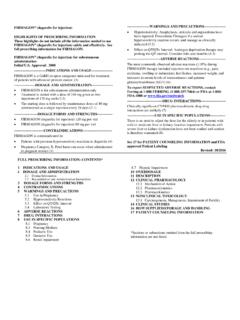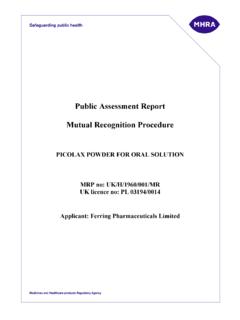Transcription of CONSENSUS Consensus Guidelines for the …
1 CONSENSUSC onsensus Guidelines for the Diagnosis and Treatmentof growth hormone (GH) Deficiency in Childhoodand Adolescence: Summary Statement of the GHResearch Society*GH RESEARCH SOCIETY Medical Department M, Aarhus Kommunehospital, DK-8000, Aarhus C, DenmarkReceived March 20, 2000. Revision received July 11, 2000. AcceptedJuly 12, all correspondence and requests for reprints to: GRS Secre-tariat, Medical Department M, Aarhus Kommunehospital, DK-8000,Aarhus C, Denmark.* These CONSENSUS Guidelines have been endorsed by the followinginternational societies: the Councils and Drug and Therapeutics Com-mittees of the European Society for Pediatric Endocrinology and theLawson Wilkins Pediatric Endocrine Society. It has also been endorsedby the Councils of the Australasian Pediatric Endocrinology Group, theJapanese Society for Pediatric Endocrinology, and the Sociedad Latino-americana de Endocrinologia Pediatrica.
2 List of participants in the growth hormone Research Society Work-shop on Child and Adolescent growth hormone Deficiency, Eilat, Israel,October 17 21, 1999: Dr. Kenneth M. Attie (Genentech, Inc., South SanFrancisco, CA), Dr. Bengt-Ake Bengtsson (University of Goteborg, Sahl-grenska Hospital, Goteborg, Sweden), Dr. Sandra L. Blethen (Genentech,Inc.), Dr. Werner Blum (Eli Lilly & Co., Bad Homburg, Germany), Cameron (Royal Children s Hospital, Parkville, Australia), Claude Carel (Ho pital St. Vincent de Paul, Paris, France), Dr. LenaCarlsson (Sahlgren Hospital, Goteborg, Sweden), Dr. John J. Chipman(Eli Lilly & Co., Indianapolis, IN), Dr. Jens Sandahl Christiansen (AarhusKommunehospital, Aarhus, Denmark), Dr. Peter Clayton (ManchesterChildren s Hospital, Manchester, UK), Dr. David R. Clemmons (Uni-versity of North Carolina, Chapel Hill, NC), Dr.
3 Pinchas Cohen (MattellChildren s Hospital, Los Angeles, CA), Dr. Stenvert Drop (Sophia Chil-dren s Hospital, Rotterdam, The Netherlands), Dr. Kenji Fujieda (Hok-kaido University School of Medicine, Sapporo, Japan), Dr. Ezio Ghigo(University of Turin, Turin, Italy), Dr. Raymond L. Hintz (StanfordUniversity, Stanford, CA), Dr. Ken Ho (The Garvan Institute of MedicalResearch, Sydney, Australia), Dr. Mbelenge Mapoko Ilondo (Novo Nor-disk A/S, Bagsvaerd, Denmark), Dr. Hector Jasper (CEDIE-CONICET,Buenos Aires, Argentina), Dr. Bernd Jesussek (Ferring PharmaceuticalsLtd., Kiel, Germany), Dr. Anne-Marie Kappelgaard (Novo NordiskA/S), Dr. Zvi Laron (Schneider Children s Medical Center of Israel,Petah Tiqva, Israel), Dr. Barbara M. Lippe (Pharmacia & Upjohn, Inc.,Los Angeles, CA), Dr. Saul Malozowski (FDA, Rockville, MD), E.
4 Mullis (Inselspital, Bern, Switzerland), Dr. Sabine de Muinck-Keizer-Schrama (Sophia Kinderziekenhuls, Rotterdam, The Nether-lands), Dr. Yoshikazu Nishi (Hiroshima Red Cross Hospital, Hiroshima,Japan), Dr. John S. Parks (Emory University School of Medicine, Atlanta,GA), Dr. Charlotte Phelps (Ferring Pharmaceuticals Ltd., Copenhagen,Denmark), Dr. Michael Ranke (University of Tubingen, Tubingen, Ger-many), Dr. Iain Robinson (National Institute for Medical Research, Lon-don, UK), Dr. Ron G. Rosenfeld (Oregon Health Sciences University,Portland, OR), Dr. Susan Rose (University of Tennessee, Memphis, TN),Dr. Paul Saenger (Albert Einstein College of Medicine, New York, NY),Dr. Guissepe Saggese (Universita degli Studi di Pisa, Pisa, Italy), diagnosis and treatment of GH deficiency (GHD) dur-ing childhood and adolescence have been the subject of muchcontroversy (1 3).
5 To insure that patients are appropriatelyidentified and treated, the GH Research Society (GRS) con-vened a workshop, on October 17 21 1999, in Eilat, Israel. Theobjectives of this workshop were to formulate consensusguidelines for the diagnosis and treatment of children andadolescents with GHD. The GRS invited clinicians and sci-entists with expertise in the field, representatives from in-dustries involved in the manufacturing of recombinant GH,and representatives from health authorities from a numberof countries to attend the workshop. All of them contributedto the CONSENSUS Guidelines as detailed of GHD in childrenThe diagnosis of GHD in childhood is a multifaceted pro-cess requiring comprehensive clinical and auxological as-sessment, combined with biochemical tests of the GH-insu-lin-like growth factor (IGF) axis and radiological may present as an isolated problem or in combinationwith multiple pituitary hormone deficiency (MPHD).
6 Eachcomponent of this process requires criteria, each of whichwill be considered and auxological evaluation for GHD in ashort child, where short stature is defined as a height morethan 2sdbelow the population mean, should not be initiateduntil other causes of growth failure, such as hypothyroidism,chronic systemic disease, Turner syndrome, or skeletal dis-order, have been considered and appropriately facts in the history and physical examination that mayMartin Savage (St. Bartholomew s Hospital School of Medicine, London,UK), Dr. Stephen Shalet (Christie Hospital, Manchester, UK), Dr. PierreC. Sizonenko (Hopital Universitaire Cantonal des Enfants, Geneva, Swit-zerland), Dr. Christian Strasburger (Ludwig Maximilians Universitat,Munich, Germany), Dr. Katsuhiko Tachibana (Kanagawa Children sCenter, Yokohama, Japan), Dr.
7 Toshiaki Tanaka (National Children sMedical Research Center, Tokyo, Japan), Dr. Michael O. Thorner (Uni-versity of Virginia Health Sciences Center, Charlottesville, VA), Albertsson Wikland (Pediatric growth Center, Goteborg, Swe-den), and Dr. Zvi Zadik (Kaplan Hospital, Rehovot, Israel).0021-972X/00/$ 85, No. 11 The Journal of Clinical Endocrinology & MetabolismPrinted in 2000 by The Endocrine Society3990indicate that GHD could be present include: 1) in the neonate:hypoglycemia, prolonged jaundice, microphallus, or trau-matic delivery; 2) cranial irradiation; 3) head trauma or cen-tral nervous system infection; 4) consanguinity and/or anaffected family member; and 5) craniofacial is recognized that short stature is often the only featurepresent. Criteria to initiate immediate investigation include:1) severe short stature, defined as a height more than 3sdbelow the mean; 2) height more than the mid-parental height; 3) height more than 2sdbelow the mean anda height velocity over 1 yr more than 1sdbelow the meanfor chronological age, or a decrease in heightsdof more over 1 yr in children over 2 yr of age; 4) in the absenceof short stature, a height velocity more than 2sdbelow themean over 1 yr or more than over 2 yr; thismay occur in GHD, presenting in infancy, or in organicacquired GHD; 5) signs indicative of an intracranial lesion;6) signs of MPHD; and 7) neonatal symptoms and signs should be noted that the interpretation of growth datarequires the most recent relevant population standards avail-able.
8 Where possible, these standards should be updatedevery 10 20 yr, dependent on the population secular data should be expressed assdscores rather than aspercentiles. To correctly evaluate height velocity, there is aneed for longitudinal velocity standards. Biological markersoutside the GH-IGF axis, such as body composition, bonedensity, and bone markers are presently not discriminatoryfor the diagnosis of the increasing use of magnetic resonance imaging(MRI), it is recognized that an incidental MRI abnormalitywithin the hypothalamic-pituitary region may be requires clinical evaluation of the child and possiblygrowth surveillance. In the appropriate clinical context, anophthalmological examination may be for genetic precise etiology of geneticdisorders of GHD and MPHD ( and POU1F1mutations) are being increasingly recognized.
9 Pointers tosuch conditions include: 1) early onset of growth failure, 2)positive family history and possible consanguinity, 3) heightmore than 3sdbelow the mean, and 4) extremely low GHresponse to provocation tests, including GHRH, and verylow IGF-I and IGF-binding protein-3 (IGFBP-3) for genetic mutations are presently only available inresearch laboratories. It is preferable that these tests becomemore widely available. Efforts to bank DNA should be made,respecting ethical and legal age estimated from an x-ray ofthe left wrist and hand should be undertaken as part of theroutine evaluation of children with growth failure over 1 yrof age and should be read by an experienced person. Ininfants less than 1 yr, bone age estimated from x-rays of theknee and ankle may be nervous system imaging by MRI or computerizedtomography (CT) is required in those with known or sus-pected intracranial tumors, optic nerve hypoplasia/septo-optic dysplasia or other structural or developmental anom-aly.
10 In confirmed isolated GHD or MPHD with or withoutgenetic defects, the following features should be recordedfrom the MRI (ideally in 2-mm slices with and without con-trast): pituitary height and/or volume, anatomy of the stalk,and position of the posterior pituitary. However, it is rec-ognized that more normative morphological data are re-quired to improve the quality of this assessment. The reso-lution of the hypothalamic-pituitary region is inferior on CTscanning, but the latter is useful for tumors and bone ab-normalities. Intracranial calcification, as often seen in cra-niopharyngioma, can be detected on skull assessment of GHD. Assay considerations:Atpresent, there is a wide range of assays available to measureGH, IGF-I, and IGFBP-3. To improve standardization, it isrecommended that the GH reference preparation should bea recombinant 22-kDa human GH (hGH; presently 88/624,which has been assigned a potency of 3 IU51 mg).





